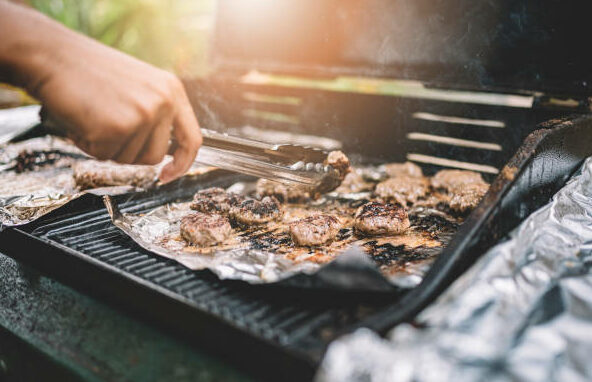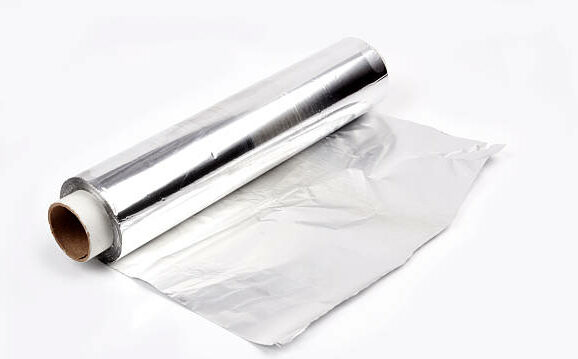
You shouldn’t bake your bread any hotter than 1200 degrees Fahrenheit (660 degrees Celsius), which is the melting point of aluminum. Because a thin coating of aluminum oxide develops on the surface of the solid metal below that temperature, aluminum is generally corrosion resistant and non-reactive. You should be OK if you stay away from toxic chemicals and strong acids.
You won’t be able to get your kitchen up to these temperatures very often. Even if the aluminum foil melts a bit (which likely means the food is burned), it probably won’t hurt anything, particularly if you wrap the food well so that the aluminum foil that touches the food wasn’t melted.
As long as the aluminum is mostly pure, its melting point is not affected by its shape, which could be powder, blocks, foil, or something else. The shape is not a characteristic of the metal, but the melting point is.
The temperature of an oven is between 500 and 600 degrees Fahrenheit and is about half of the maximum temperature aluminum foil could handle. So, you do not need to worry if aluminum foil will catch fire in the oven.
However, if you put aluminum foil on the bottom of your oven, it may melt and stick. In addition, laying aluminum foil on the oven’s bottom may permanently damage the oven’s heating element.
How To Cook with Aluminum Foil in The Oven?
Metal foil, a thin sheet of aluminum, has established itself as an essential cooking tool. Cooking using aluminum foil not only helps heat transfer easily and simplifies cleaning, but it is also safe to use in the oven.
Aluminum foil, which is more adaptable and durable than tin foil, is an excellent baking partner since it reflects heat and can withstand the greatest baking temperatures normally seen in home ovens. Aluminum foil is ideal for use as a baking sheet liner, for wrapping food to keep it fresh, and for covering food to keep it wet.
Prepare the baking sheets and pans
Lining baking trays and pans with aluminum foil is an excellent way to make cleanup easier. After baking cookies, slices of bread, or other foods, you can easily take them out of the pan by sliding or lifting the foil.
The manufacturing process gives aluminum foil a shiny side and a dull side. However, the side that is exposed depends on the intended usage. The non-stick coating is on the dull side of non-stick aluminum foil, so when baking sticky foods, put this side up. If you don’t want that, you can help certain foods brown by putting the shiny side down.
Cover the food
When you bake something, covering it with aluminum foil helps keep in the moisture. The top of a dish may be prevented from browning by loosely tenting or laying a layer of aluminum foil over the dish. If you want to make more steam while baking, putting a tight foil lid on the dish does the trick.
Using disposable baking dishes
Aluminum pans, trays, and other disposable baking dishes can be used instead of metal dishes. They offer the same high heat resistance as aluminum foil and good heat conduction capabilities, so they’ll help your food cook quickly no matter how hot your oven gets.
Aluminum Foil Substitutes for Baking

Now that you know when and when not to use aluminum foil in the oven, what should you do next? Know what you can do. If you don’t like baking with aluminum foil, you should know what else you can do. Some of the options are:
Cookie Sheet or Baking Pan
As was already said, you may use a cookie sheet or baking pan instead of aluminum foil. It does the same thing as aluminum foil, but there is no chance that it will break. Most baking pans come with handles that are easy to hold and raised edges that don’t stick. If you want to prevent liquids from splashing all over your oven, use a baking pan.
Silicone Sheet for Baking
A silicone baking sheet is another way to catch food that spills and drips inside the oven. You can line the oven rack with a silicone baking sheet, but not the bottom. Silicone baking sheets are safe, don’t contain any harmful chemicals, are easy to clean, and can handle temperatures up to 500 degrees Fahrenheit.
Parchment Paper
The baking sheet may be lined with parchment paper instead of aluminum foil if you want. In the oven, parchment paper can be used the same way that aluminum foil can. But the surface of parchment paper doesn’t stick as aluminum foil does. The parchment paper would be ideal for baking things like keto.
But if you use parchment paper, check the manufacturer’s suggestions for the highest temperature you can bake at. In general, parchment paper can handle temperatures as high as 420 degrees Fahrenheit. Finally, if your oven uses gas and has a broiler, you should not use parchment paper.
Dutch Oven
Dutch ovens may be used in place of aluminum foil for baking in the oven. A Dutch oven is constructed from iron or ceramic and has a tight-fitting lid that keeps the moisture in. This makes it a great alternative to aluminum foil for wrapping food.
Conclusion
Grilling is the best way to use aluminum foil. Due to its heat resistance, aluminum foil is ideal for lining baking pans in the oven. But you shouldn’t position them on the bottom of the oven with foil to trap drips and spills because foil can melt at high temperatures and cause damage to the oven.
